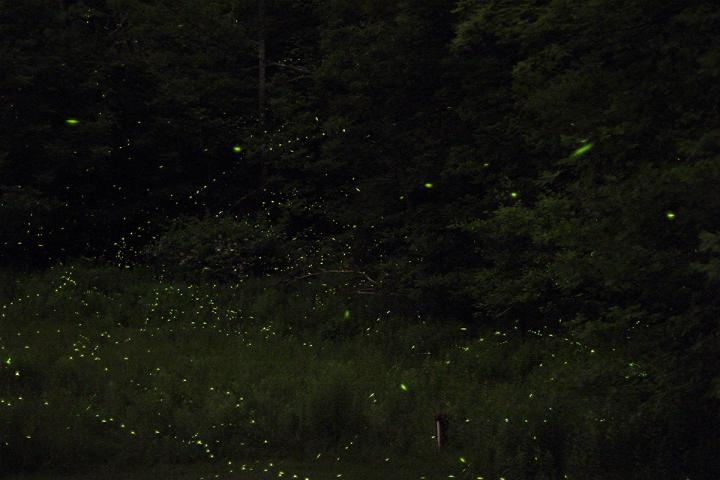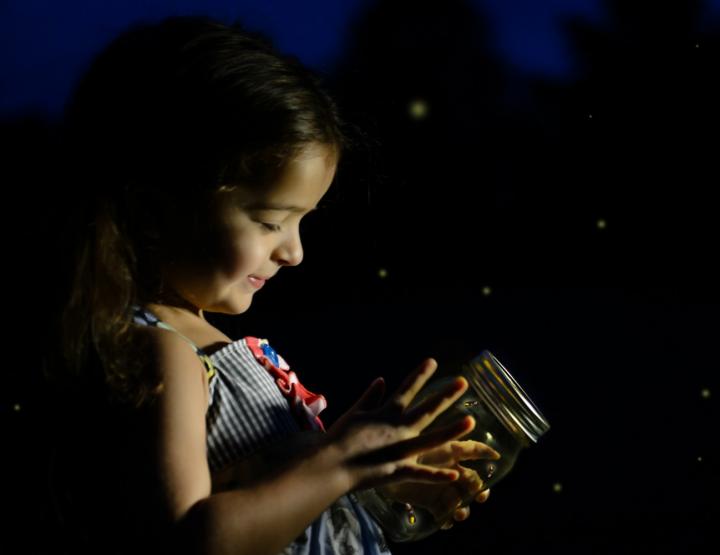George and Becky Lohmiller
Fireflies, or lightning bugs, have been captivating humans for centuries with their beautiful lights on summer nights. What makes fireflies glow the way they do?
The nearly 2,000 species of fireflies worldwide inhabit every continent except Antarctica. The firefly, or lightning bug, isn’t a fly at all, but a beetle from the family Lampyridae, which in Latin means “shining fire.” This “fire” that makes fireflies so fascinating is really a method of communication for lightning bugs. They form a beautiful language with light (as opposed to most animals’ languages of sound).
Why Do Fireflies Glow?
- Photocytes, or light cells, in the insect’s abdomen are where the glow is produced.
- The light is the result of a chemical reaction known as bioluminescence that occurs when two substances, luciferin and luciferase, react with one another when exposed to oxygen.
- The firefly regulates the flow of oxygen into its abdomen to turn its taillight on or off.
- This cold, living light is almost 100 percent efficient, losing only a fraction of its energy to heat. By comparison, a standard incandescent light bulb is less than 10 percent efficient!
- The main idea of a firefly’s light show is to attract a mate. The males fly around while turning their lights on and off, hoping to get the attention of a flightless female waiting in low vegetation. They try to flash very quickly, because this is what attracts females.
- If a female is impressed by a male’s flickering, she will flash back a response to the twilight glow. The brighter the female’s response, the more interest she has in the male.
- Each species of firefly has its own unique flash that is characteristic of its sex and species.
- Carnivorous females of the genus Photuris are known to entomologists as “femmes fatales.” These fireflies mimic the flashes of females of other firefly genera; the unsuspecting courting male flies in (expecting romance) and is promptly eaten.
- A lightning bug’s light can also serve as a warning to predators. In the same way that bees scream “Danger!” with their black and yellow stripes, fireflies show their toughness with their light. Fireflies even have an advantage over bees, because their warning can be seen in the dark!

Photo Credit: Wesleyan University. Fireflies are often found in meadows or next to creeks, as they like damp areas.
How to Find Fireflies
- Fireflies like to be out when mosquitoes are out: in cool, damp, dim conditions. This means that you might get chewed by mosquitoes when looking for fireflies. There are some easy ways to protect yourself from mosquitoes, but if you can’t help but be bitten, check out our remedies for bug bites.
- Just like mosquitoes, fireflies like to be near swampy areas or creeks.
- Unfortunately, some common methods of deterring mosquitoes (like using a pesticide) also deter fireflies. If you use mosquito-deterring techniques in your yard, you’ll have to look somewhere else.
- Try to find an area with very little light pollution: a meadow, the edge of a forest, or even your backyard if you don’t live in an urban area. Also, keep the outdoor lighting at your home dim.
- Go out to look for fireflies soon after sunset. If you stand still and watch carefully, you just might see a few!
- Fireflies don’t come out until the warmth of spring, so wait until the spring and summer months of May, June, and July to search for them.
How to Attract Fireflies
The best way to attract these blinking bugs is to turn your yard or garden into the ideal firefly environment:
- Fireflies appreciate shrubs and low trees for daytime shelter, so consider planting some to keep them around.
- Fireflies like to hang out in grassy meadows, so if you want them to visit your property, let some parts of your lawn grow out or plant tall ornamental grasses. They enjoy perching on the tips of long blades of grass while searching for a mate.
- Place bird baths in grassy areas or near shrubs; fireflies will appreciate the water source.
- Don’t use mosquito-repelling chemicals in your garden, as these will also repel fireflies.
More Fun Firefly Facts
- Fireflies taste horrible to predators like birds and mice. They release a bitter defensive chemical when eaten, which helps to keep predators away.
- All fireflies are bioluminescent as larvae (which is why the larvae are often called glowworms), but not all of them shine as adults. The fireflies that lose their ability to make light use scent to find mates instead.
- Even though a firefly’s light is triggered by oxygen, fireflies do not have lungs. Instead, they inhale oxygen through tubes called “tracheoles.”
- A lightning bug’s flash can be yellow, green, or even blue!
- Fireflies are only about ½ inch long, and they have very big eyes so that they can see the flashes of other fireflies.
- Fireflies (as well as their larvae, glowworms) help to control garden pests like snails, slugs, cutworms, and aphids, so be sure to keep them around if you have them in your garden.

Photo Credit: Clemson University. It is important to protect beneficial firefly populations, so be sure to release them from jars.
Though many people love to catch fireflies in jars and keep them around, fireflies can be much more beneficial in your yard than in your house. Even if you keep them in a jar for a few hours, be sure to release them again. And for the effect of putting lightning bugs in a jar without bothering any of them, try our Mason Jar Lid with Star Lights.
Let your love light shine with these dazzling garden friends, and let us know in the comment section if you’ve found lightning bugs in your garden!
Posted on June 22, 2018
0